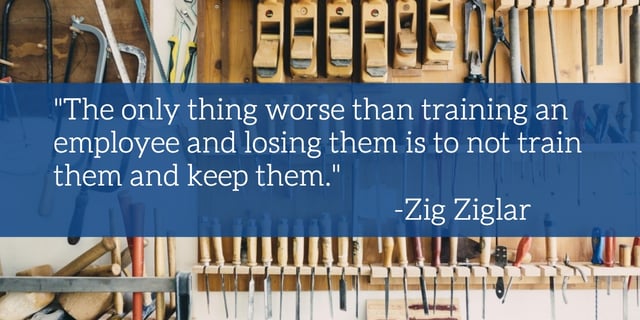
Employee training sometimes gets pegged as part of the onboarding process only. Even then, many companies opt to keep it short and sweet, covering only the most necessary topics, in the most cursory ways. Given that any time an employee sits in a training session is time they’re not working, this is an understandable approach.
Two points of resistance to extended or ongoing employee training programs sound a little something like this:
- Employees tune out during formal training presentations, especially if they last too long.
- If we put a lot of time and effort into an immersive ongoing employee development and training program, employees could just leave the company as soon as they’ve mastered the job.
But as common as these attitudes are, they’re pretty wrong-headed. Excellent, thoughtful training doesn’t just help your new hires do their job better. It can actually make them more loyal to your company. Continually investing in existing employees’ ongoing learning can have the same effect on employee retention.
 Here are a few (of many) reasons that the right kind of training and employee development programs may be one of your best retention strategies:
Here are a few (of many) reasons that the right kind of training and employee development programs may be one of your best retention strategies:
- It shows employees that you’re invested in their personal and professional career growth.
- It helps your workforce develop new skills and feel confident in their ability to succeed on the job.
- It creates connectivity between peers, increasing job satisfaction.
- It helps new hires get a handle on the corporate culture and find their role within it more quickly.
- It keeps the lines of communication between management and staff open.
- It improves or maintains employee engagement.
But what about the potential cost of time lost on training? Or the cost of hiring professionals to help develop strong training programs?
If a motivated, engaged, competent staff isn’t enough of a draw, consider the cost of employee turnover. Estimates for replacing existing staff range from 30-50% of a salary for entry-level employees, to a whopping 400% of the salary of a highly-specialized employee. Keeping your people happy and in their jobs is a huge financial boon to your team. Spending a fraction of the cost of turnover on training initiatives could constitute savings in the long run (to say nothing of the added productivity).
If the idea of subjecting your staff to a dry presentation by some outside consultant bums you out, that’s because it should. The best learning experiences for employees come from experience on the job, not formal presentations. There are much better ways to approach continuing education that keep employees engaged in their learning, but also in their jobs.
One popular way to present important HR-related topics (such as sexual harassment, discrimination or job safety) is to use online training presentations. This option allows your employees to complete their training during a time that makes most sense for them individually, as well as at a speed that is manageable for each person. It also comes with the added benefit of built-in checks for understanding.
Online training is also a great way to help employees pick up specific skills for their jobs on an ongoing basis. Consider creating a library of resources so that your staff can complete training modules to improve their skills if they have a slow moment at work.
Some companies have had success with more free-form continuous learning initiatives, like points systems. Employees choose training tasks that appeal most to them, which gets them to buy into their own development. Points can be awarded for tasks like shadowing a more senior employee for a few hours, reading a book and hosting a discussion about it, or choosing and attending a training session outside the office.
For many industries, mentorships can be an excellent way to foster engagement and learning. They allow staff to learn from each other on the job, and they can help keep all involved parties engaged in their work. More tenured staff will benefit from revisiting the fundamentals of their roles, and newer employees can get soft skills training and learn time-saving steps that might otherwise take them years on the job to figure out.
There is always a baseline level of turnover risk in any company, but the looming potential of an employee’s departure is no reason to avoid investing in their learning. Spending time and energy on each person's ongoing professional development will reap rewards in productivity, and potentially in increased engagement and loyalty.
